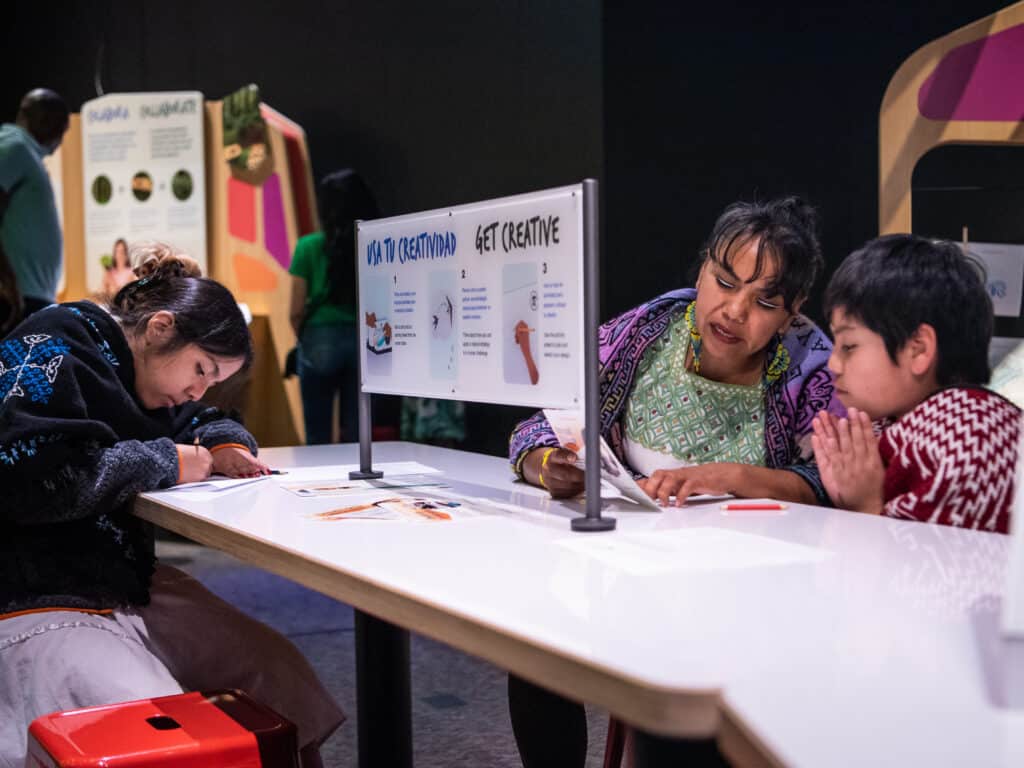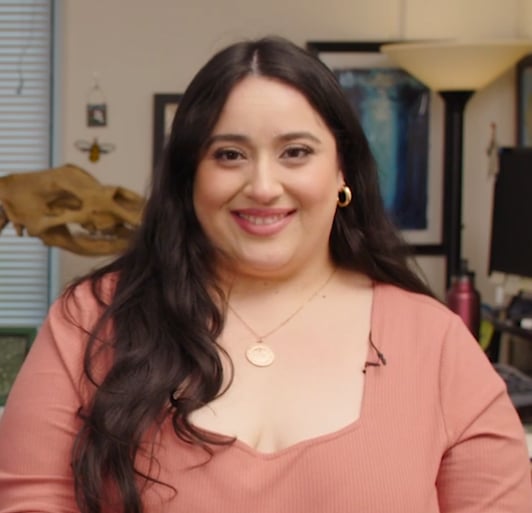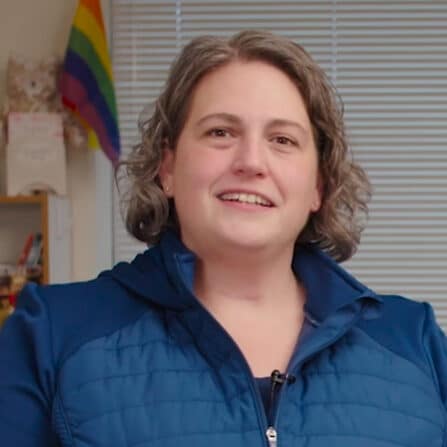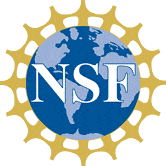

Sierra is a research and evaluation assistant at OMSI.

Katie is an educator at OMSI.
This three-session, personal-professional development program (PD) is an opportunity for you and teams of informal educators to reflect on your own understanding of and the usefulness of engineering practices. For this PD, we define usefulness as being the perception that an object, activity, or information is relevant and can be applied to a personal goal or situation. As a result, PD participants will be able to use specific elements of personal stories to engage in conversations that boost visitors in self-generating the value of the engineering practices they already use in their daily lives and when addressing community level challenges.
By engaging with this PD, you can:
- Update your definition of engineering in everyday language that reflects engineering as an inclusive process, and a means all people use to achieve goals.
- Update your notion of engineering to include engineering as not only processes, but also as sets of practices; practices that can be collaborative and informed, including among intergenerational groups.
- Update your toolkit to recognize story sharing as a process that fosters personal sense-making among those involved; story sharing about engineering practices can lead to self-generated connections of how engineering practices are used to accomplish daily activities, including contributions to community goals.
This web-based PD is designed for both individuals and teams. Most modules start with individual work and end with opportunities for group discussion and reflection. Please feel free to adjust how you engage with the content to meet your needs.
Please click on the relevant module below to access module video and materials.
Module 1: What is Engineering?
Materials
Before proceeding with this module, please make sure that have the following materials available and ready for use
What is engineering?
Every person who comes to your museum brings their own wealth of knowledge and experience. They get to choose what they are interested in exploring and how much time they want to spend at any given exhibit. As museum staff, our job is to help support learners’ journeys. However, just like our visitors, we too bring our own experiences and interests to every interaction. How each of us individually identifies with STEAM (science, technology, engineering, art, and math) has the potential to shape how we interact with learners at our museums.
Engineering has its own stereotypes that are perpetuated in society. For example, in schools, engineering design activities often focus on the same challenges used for generations: building bridges, designing projects that protect fragile items from a fall, designing boats, and using LEGOs bricks to build towers. These examples reinforce the idea of engineering as a professional and college related career. However, research in museums confirms that more people engage with the engineering design process when engineering is designed and presented as altruistic, creative, and collaborative (Lakin & Davis, 2019). Examples of this approach include designing and building a zip line carrier that will move an injured or stranded person safely and quickly out of danger or generating ideas for creative designs that will help different people and animals in various disaster scenarios.
Even when presenting and designing engineering in altruistic ways, an ongoing challenge is that the engineering design process is often associated with engineering careers, many of which involve higher education. However, regardless of our education or how we identify with the STEAM field, we all use engineering practices in our everyday lives and with our communities. As educators, we have the opportunity to expand the view of engineering to highlight how we as individuals and communities use engineering practices.
In this module, you will have a chance to reflect on your own personal definition of engineering and explore ways in which people talk about engineering.
Activity 1
Before proceeding, we would like you to use the Module 1 Worksheet to reflect on these engineering questions:
- Describe what comes to mind when you think of engineering. Feel free to use a drawing, a poem, a personal experience, make a list, etc.
- Look up “engineering.” What are some ways mainstream media describes engineering? What are some contexts in which it is described?
- Think about the influence the media has on changing narratives. Do you think that could apply to engineering?
Activity 2
Now that you have had an opportunity to think about how you describe engineering, watch this video to hear how Sierra, Katie, and museum visitors relate to and think about engineering.
Activity 3
As part of the interviews, we purposefully changed the way questions were asked, shifting from a technical to a more practical (or everyday) approach. Go back and watch the video again, this time paying attention to the difference in responses based on how the interviewer asked about engineering. What do you notice this time?
For the Designing Our Tomorrow (DOT) project, we defined engineering as “a problem-solving approach that involves strategies and skills anyone can use to solve challenges within their day-to-day lives and in their communities”. What has come to mind as you’ve spent this time reflecting on engineering?
In Module 2, you will look at a new framework that identifies the nuanced engineering practices people already use while interacting with exhibits. Understanding these practices can help us make, evolve, and/or strengthen people’s connection with engineering.

You have finished Module 1, PROCEED TO MODULE 2.
Module 2: Engineering Practices at Exhibits
Materials
Before proceeding with this module, please make sure that have the following materials available and ready for use
Engineering at Exhibits
You will begin this module by watching the Engineering Practices in Action video, a compilation video of families using exhibits at the Creatividad silvestre | Wild Creativity exhibition.
These families were filmed as they worked together; no facilitators or educators were present. As you watch the video, use the Engineering at Exhibits section of the Module 2 Worksheet to record at least three specific moments that suggest families are using engineering at an exhibit.
Engineering Practices at Exhibits
Many people are familiar with some version of an Engineering Design Process – common steps in this process include ask, research, imagine, plan, create, test, and improve. We have included an example of an Engineering Design Model from Head Start on Engineering (https://www.terc.edu/hse/), in the materials for reference. Engineering design process models are great at identifying the steps or phases that people use during a design cycle. As facilitators, we can help people connect these broad phases such as “imagine’ or ‘test” to their actions, ideas, and conversations at an exhibit.
The evidence- and theory-based C-PIECE Framework (Collaborative Practices at Interactive Engineering Challenge Exhibits) was developed by researchers and educators at OMSI to provide a nuanced lens of engineering design practices. The C-PIECE Framework is designed to measure, study, and improve the use of engineering design practices by visitor groups within an engineering exhibit context, and ultimately, to inform the development of informal engineering education experiences such as those in the Creatividad silvestre | Wild Creativity exhibit.
The C-PIECE framework is divided into two overarching engineering steps:
- defining a problem, and
- improving a design.
Each step has sets of practices and each practice is categorized as beginning, intermediate, or informed.
This tool focuses on specific engineering practices such as “identifies/assigns roles” or “optimizes design and materials”. Understanding and using this framework can support facilitators with conversations that connect the engineering practices people use in the exhibits to how they already use them in their daily lives
Activity 1
Please print or open the provided C-PIECE Framework and either the Engineering Design Process document from HSE or one that your institution uses. Compare the engineering design process and the C-PIECE Framework. In the Module 2 Worksheet, write down how the practices in the framework complement and support the engineering design process.
Once you are done exploring the C-Piece Framework, rewatch the Engineering Practices in Action video and try to identify at least three engineering practices from the C-Piece Framework that are being used by the families. Record your observations in the Engineering Practices at Exhibits section of the Module 2 Worksheet. Make sure to have the C-PIECE Framework with you for reference and be prepared to pause throughout the video as you match the C-PIECE practices to those used by the families in the video
Observing Engineering Practices in Action
Now that you’ve had a chance to explore the C-PIECE Framework and engineering practices, it’s your turn to make observations at your museum.
We created an Observation Form much like the one used in the evaluation of the Creatividad silvestre | Wild Creativity exhibit. Take some time to familiarize yourself with the Observation Form and the operational definitions of practices found in the C-PIECE Framework.
To simplify things, the Observation Form is organized around ten topics ; some of these align directly with an engineering practice from the C-PIECE Framework while others may capture multiple practices. To begin with, pick two or three topics to focus your observation on. As you become more familiar with the form, you can observe more if you wish, or simply focus on those topics that are most relevant and interesting to the work you are doing.
If you don’t have engineering exhibits, demonstrations, or programs, you can also look for these same practices in any museum job, team meetings, at home, and during day to activities.
If you are doing this PD as a group, it can be helpful to make observations in pairs. Oftentimes, we might miss how a visitor uses a practice at an exhibit but someone else will catch it. Talk to your co-workers and observe together.
How might the sets of engineering practices used at exhibits, like in the C-PIECE Framework, change how you support guests?
In the next module, we will talk about conversations in which people make connections with their day to day lives. Which of the C-PIECE Framework practices do you imagine people engaging in as part of their daily lives?

You have finished Module 2, PROCEED TO MODULE 3.
Module 3: Storytelling for Connections
Materials
Before proceeding with this module, please make sure that have the following materials available and ready for use
Personal Connections to Engineering Practices
Module 1 and Module 2 of this PD focused on describing engineering and finding connections with engineering practices people use at exhibits. The activities in Module 3 bring those aspects together to explore how we talk and learn with visitors about engineering practices at exhibits.
Museums must continue working towards being culturally relevant and inclusive for our museum guests. Many commonly used science narratives are rooted in dominant, white, western, culture. As museum professionals, how can we move away from being the people with the answer or the experts to a place of centering the visitor’s experience and knowledge with engineering practices?
Story sharing with conversation can be a facilitation approach that helps us and visitors relate content to personal lives. The power of stories is that they can shift the power balance in conversations away from education staff to our visitors by centering visitors’ lived experiences. Changing the ways engineering is talked about allows each of us to make our own meaning through the conversation.
To learn more about how story sharing can be useful to museum educators, OMSI hired four Storytelling Ambassadors to join the Museum’s research team. Over the course of a year, the Storytelling Ambassadors had three opportunities to create stories and share them in one-on-one conversations virtually hosted with parents and other caregivers (throughout this PD, we’ll use “caregivers” as a term that includes parents and other people who support children’s learning) from the San Diego area. We called these caregivers the “active audience” because we wanted them to do more than just listen. As we shared our short stories, we explicitly invited them to share their experiences with us. Each of our stories were about three minutes long and focused on one to two engineering practices seen at exhibits and used in personal or community level challenges. Watch this video to learn more about the process.
Activity 1
For this first activity, you are going to start the process the same way.
Using the Personal Connections to Engineering Practices table in the Module 3 Worksheet, make a short list of activities or routines you regularly do during the day or over the course of a week.
Then, take a couple of those activities and map out which of the engineering design practices you use to complete the activity. We have included an example to help you begin.
We encourage you to look at processes in the intermediate and informed categories. When you are done, move on to the next part, Sharing Stories, of this module.
Sharing Stories
The Storyteller Ambassadors worked with OMSI’s Research Team to study how sharing stories as part of a conversation can help people make connections between engineering practices used at the Creatividad silvestre / Wild Creativity exhibits and their usefulness in our everyday lives.
In between rounds of conversations, we analyzed the feedback from the parents and caregivers and our own reflections. When we summarized our findings, we learned that for an active audience to gain insight, recognize familiar situations, feel empowered in engineering, and to share their own stories, our stories as facilitators needed to have certain elements. They needed to be personal, relatable, explicit about engineering in a social context, and have repetitive mentions of the engineering practice. If we wanted their stories to include how engineering practices connected to activities they do for their communities (however they chose to define community), then our conversation needed to include elements of our communities, too.
After the research ended, the OMSI Storytelling Ambassadors were filmed sharing one of their stories with caregivers at OMSI. From those videos, we compiled small segments that highlight the use of the storytelling elements into a short video.
Activity 2
Take a moment to watch the Let’s Talk About Engineering and look for elements that are personal, relatable, explicit about engineering in a social context, and repetitive mentions of the engineering practice.
Make notes of what you observed in the Sharing Storiessection in the Module 3 Worksheet.
After you review the videos, continue to the next section of this module, Creating Your Own Story.
Creating Your Own Story
Now it’s time for you to create your own story using one of the engineering practices you observed at an exhibit during Module 2 to your daily life or in your support of community efforts.
If you don’t have engineering related exhibits or programs at your museum, think about meetings, demos, and/or activities you participate in. For an additional dimension, see if you can create a personal story that connects engineering practices to a challenge faced by a community you belong to. Remember, communities can include cultural groups, interest groups, religious communities, fellow museum professionals, online groups, book clubs, quilting clubs, gaming groups, etc.
Use the Story Planner we developed to guide you through this process. You can have the C-PIECE Framework available to help you decide which engineering practice you want to highlight. Remember, try to choose practices in the informed or intermediate levels. Use your filled out story planner to help guide your story creation. Aim for a story that is no longer than three minutes.
Once you have written and edited your story, find a co-worker or friend with whom you can share your story. The goal of conversation is twofold: You are trying to get the person you are talking with to 1) share that they use the practice or a similar one and 2) give examples of how they already use the practice(s) or could in the future. How they use a practice(s) ideally reflects the usefulness of the engineering practice.
You might need to revise parts of your story several times before you are able to elicit connections from your audience. Remember, the goal is to share your own story in a way that allows others to create personal meanings. You’ll know your story has connected when guests share with you how they use engineering practices in their daily lives and with their communities.
For your reference, we included two full written stories from the OMSI Storytelling Ambassadors. The design and format of each story is unique to each person.

You have finished Module 3, PROCEED TO WRAP-UP.
Wrap-up
Congratulations on completing all three modules! So, what now? Some educators participating in this training might already be comfortable and connected with engineering. Some educators may struggle with seeing themselves using engineering practices. We can expect a similar diversity of experiences among visitors to our museums.
As you’ve experienced, engineering is not limited to just technical skills. Engineering is an inclusive practice. You don’t need to fit a specific mold or have a certain background to take part in engineering. Unique perspectives and contributions can greatly enhance the way we look at engineering. Skills such as communication, problem-solving, and teamwork are essential parts of engineering. These diverse skill sets and perspectives foster collaboration and help us tackle challenges from different angles, leading to innovative and effective solutions to complex problems.
Utilizing the elements of story sharing is a tool we have to help support visitors to make their own personal connections and center their lives and lived experiences at our museums.
However, unlike the DOT research project, educators generally do not have the opportunity to share a three-minute story with a visitor, nor would we ask educators to do that. Instead, much like snippets highlighted in the last video, we can use elements of story sharing. We can be explicit and tell people they are doing engineering. We can connect the usefulness of engineering practices to things we already do – brainstorming, watching others, reading directions, explaining why something happened. By connecting engineering practices in the C-PIECE Framework to our own lives, we can have these tools ready to use.
Instead of just helping visitors successfully complete an engineering challenge, we can connect their process with personally relevant engineering practices. For example, when we see someone at an exhibit or when we are helping someone, we could say something like, “I see you are looking at all the materials before you begin. I do the same thing when I’m cooking dinner. I like to get out all of my ingredients before I start. Do you ever get out all your materials before you start a project? (Wait for them to share) When we do that, we’re using the same practices that engineers use.”
The goal of this PD has been for you and other informal educators to recognize the ways your personal stories can engage visitors. By engaging in story sharing, visitors can self-generate the value of engineering practices in their daily lives and when addressing community level challenges. We hope this PD has added story sharing as an important skill in your facilitator toolkit.

Congratulations! You have completed the DOT Educator Personal-Professional Development. You are now ready to try out the concepts from these modules in your informal education work!

This material is based upon work supported by the National Science Foundation under Grant No. DRL-1811617. Any opinions, findings, and conclusions or recommendations expressed in this material are those of the authors and do not necessarily reflect the views of the National Science Foundation.